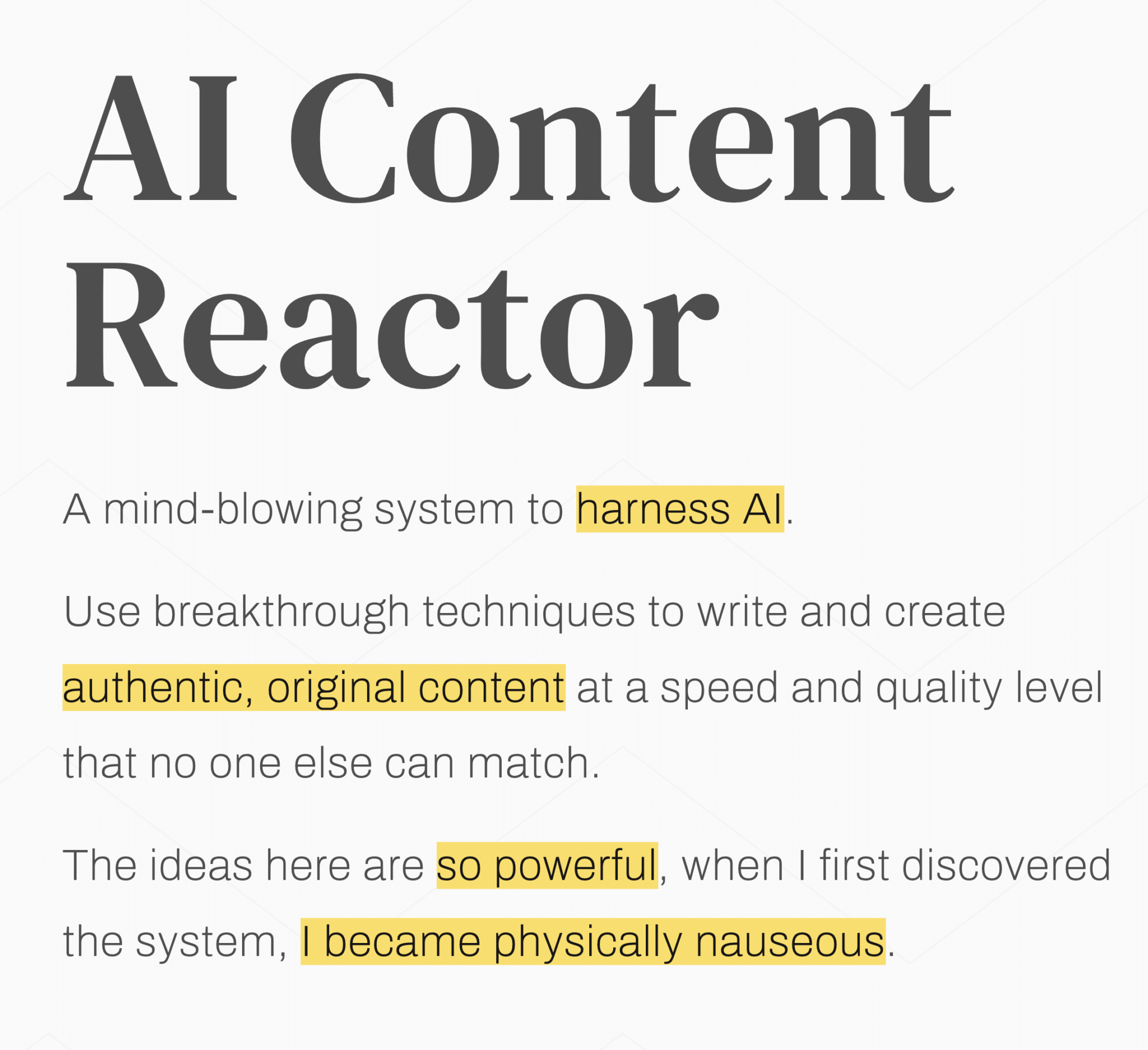Table of contents
- Simplifying SEO For Content Creators: 12 Powerful Hacks Every Content Creator Should Know
- 1. Make It A Triple Threat
- 2. Future-Proof Your SEO With SGE
- 3. Aim For Zero-Click Searches
- 4. Build It To Be Shareable By Design
- 5. Solve Their Problems
- 6. Reel In Rankings
- 7. Anchor Your Authority
- 8. Create Credible Digital Handshakes
- 9. Design Value-Oriented CTAs
- 10. Balance Tech With Touch
- 11. Create A Topic Timeline
- 12. Submit Your Sitemap Weekly
- Conclusion
Creating fantastic content is only half the battle. To make sure it is seen, optimize it with smart SEO strategies. This isn’t just written content. SEO for content creators applies to everything you make, be it blog posts, videos, or something else entirely.
SEO might seem like a whole new world, but we will simplify it for you. We’ll explore 12 of the best hacks, tips, and tricks for content creation to rank higher in search results.
Simplifying SEO For Content Creators: 12 Powerful Hacks Every Content Creator Should Know
Take note of these hacks and focus on these key points to maximize the impact. But before we get to it, here’s a quick rundown of what we will cover.
| SEO Hack | Strategies to Implement |
| Make It A Triple Threat | – Useful: Identify pain points, provide clear answers, fill knowledge gaps, conduct keyword research. – Actionable: Provide step-by-step guides, actionable tips, clear calls to action. – Engaging: Use visuals, conversational tone, storytelling. |
| Future-Proof Your SEO With SGE | – Create informative, well-researched content. – Consider different search stages. – Use clear headings and subheadings. |
| Aim For Zero-Click Searches | – Answer questions directly – Keep paragraphs 40-50 words. – Aim for around 1500+ words. |
| Build It To Be Shareable By Design | – Visualize data. – Create digestible content. – Highlight key points in videos. – Use carousel posts for visual storytelling. |
| Solve Their Problems | – Understand audience struggles. – Create detailed guides, offer downloadable resources, film videos. – Use relevant keywords, promote content, include success stories. |
| Reel In Rankings | – Understand search motivations. – Use relevant keywords in titles and descriptions. – Add video transcripts with searchable text and timestamps. |
| Anchor Your Authority | – Research extensively and stay updated. – Use credible sources. – Maintain a regular publishing schedule. |
| Create Credible Digital Handshakes | – Offer unique insights. – Write for established websites. – Replace outdated links with your content. – Use analytics. – Improve user experience with internal links. |
| Design Value-Oriented CTAs | – Highlight user value. – Relate CTA to content – Give clear instructions. – Make sure CTA stands out. – Strategically place CTAs. |
| Balance Tech With Touch | – ChatGPT to generate ideas and drafts. – Grammarly to check grammar and maintain style. – SurferSEO to identify keywords and avoid keyword stuffing. |
| Create A Topic Timeline | – Define your niche and hub topic. – Identify and categorize spokes and sub-spokes. – Plan content creation using a calendar. |
| Submit Your Sitemap Weekly | – Update the sitemap with new content. – Submit updated sitemap to search engines weekly. – Use Google Search Console to submit and monitor sitemap health. |
Now, let’s cover each of these hacks in detail.
1. Make It A Triple Threat
Imagine someone comes across your content on search engine results pages (SERP). They click because the title sounds interesting, but within seconds, they are gone. Why? Your content is informative, sure, but it wasn’t what they expected.
Content Writing for SEO: How to Create Content that Ranks in Google
You need to make your content triple threat – useful, actionable, and engaging. Let’s break down what this means:
1.1. Useful
Search engines want to deliver the best possible results to users. That means your content needs to genuinely help your audience. Here’s how:
- Identify a pain point your audience has and offer a solution (more on this later).
- Research and give clear, informative answers to common questions in your niche.
- Fill a knowledge gap. Is there a specific aspect of your topic that the audience struggles with? Offer in-depth explanations to bridge that gap.
- Conduct keyword research to understand what people are searching for about your topic. Use Google Keyword Planner, SEMrush, and Ahrefs to identify and add relevant keywords throughout your content – naturally, not forced. You can also get help from our team of experts to identify what keywords your target audience is searching for and optimize your content.
1.2. Actionable
Don’t just tell people what to do, show them how. They want to take action and here’s how you can help them:
- Provide step-by-step guides. Break down complex processes into easy-to-follow steps.
- Offer actionable tips. Give the readers clear takeaways they can implement immediately.
- Tell your audience exactly what you want them to do next. It could be subscribing, downloading a resource, or visiting another page.
1.3. Engaging
Even the most informative content can get lost in the shuffle if it is boring. Here’s how to make your content stand out:
- Break up long blocks of text with informative and aesthetically pleasing images, infographics, or videos.
- Use an engaging writing style. Keep your tone conversational and avoid jargon. Instead of saying, “It is recommended to utilize fertilizer for optimal plant growth,” write, “Just like us, plants need food to grow. Fertilizers can give your garden an extra boost.”
- People connect with stories. Weave narratives into your content to make it more memorable. For instance, instead of just listing baking tips, tell a story about a baking disaster you overcame and the things you learned from it.
2. Future-Proof Your SEO With SGE
Search-Generative Experience (SGE) is Google’s latest innovation that uses generative AI to analyze search results and provides concise summaries of relevant web pages. You can even adjust the level of detail to your needs.
SGE goes beyond just finding relevant websites and instead helps you explore topics, complete tasks, and be more productive with your searches. This will completely revamp how you search for information.
Here’s the exciting part: you can create content that SGE wants. Here are the ways to do it:
2.1. SGE Loves High-Quality Content
SGE rewards high-quality content that goes deep into a topic. Focus on creating content that is informative, well-researched, and answers your audience’s questions thoroughly. If you are writing about gardening, explore different plant types, soil conditions, watering techniques – the whole package to show SGE your content is valuable.
2.2. SGE Follows Search Intent
SGE is built to understand your search flow. Instead of just focusing on target keywords, consider the different stages someone goes through when searching for your topic. For example, if you are creating a recipe blog, write valuable content that walks the reader through each step, from gathering ingredients to plating the final dish.
2.3. Content Structure Matters
Break down your content with clear headings, subheadings, and bullet points. This makes it easier for SGE to understand your content’s structure and categorize information. For instance, if you are writing a blog post on “The History of Jazz,” structure it with headings for different eras, like “Early Jazz,” “The Swing Era,” and “Modern Jazz.”
3. Aim For Zero-Click Searches
Zero-click searches are search engine results where a searcher types a question into Google and gets the answer directly on the results page, without clicking on any website. Google highlights these answers in featured snippets, knowledge panels, or answer boxes.
Here’s how you can create SEO content that gets chosen for these spots:
3.1. Target Clear, Answer-Focused Questions
Target questions, not just keywords. People search using questions. Identify the questions your target audience has and answer them directly in your content. For example, if you write about pet care, target questions like “How to bathe a cat” or “What vegetables can rabbits eat?”
This increases the chances of your content getting featured as the answer snippet at the top of the search results page. Remember, featured snippets have the highest click-through rate (CTR) at 42.9%. That means your content will get major exposure at the top of the search results and you establish yourself as an authority in your field.
3.2. Featured Snippets Favor Paragraphs
81% of featured snippets are paragraphs. Make your paragraphs easy to understand and answer specific questions. Aim for 40-50 words and one main idea per paragraph.
3.3. Longer Content Ranks Higher
Google loves long, informative content. The average length of organic search results on the first page of Google is 1,447 words. So research your topic thoroughly and create detailed pieces that average around 1500 words to increase your chances of having valuable information pulled for a featured snippet.
3.4. Structure Your Content For Readability
As we discussed earlier, structure your content logically. Use clear headings and subheadings to break your content down to help search engines understand the information flow and identify potential snippets.
4. Build It To Be Shareable By Design
Sure, social media shares don’t directly affect search engine rankings, but here’s an insider: the more people share your content, the more natural links you attract. More natural links mean more website traffic, which search engines love.
So how do you do it? People are drawn to visuals. Use them to make your content irresistibly shareable:
4.1. Infographics
Complicated data transformed into a visually stunning infographic is a surefire way to grab attention. For instance, if you are writing “Top Gardening Tips for Beginners,” you can break down these tips with colorful charts and illustrations—perfect for sharing on Pinterest or Facebook.
4.2. Snackable Snippets
Not everyone has time for long reads. Break down your content into easily digestible snippets that viewers can share. Think “Life Hacks for Busy Professionals” presented as short video clips with actionable tips – ideal for Instagram Stories or TikTok.
4.3. Compelling Videos
Create short, engaging videos that highlight key points from your content. Imagine a recipe post with a mesmerizing video showcasing the cooking process – perfect for sharing on YouTube or Facebook. We will talk more about this later in the article.
4.4. Carousel Posts
Instagram and LinkedIn offer carousel formats. Use them to tell a visual story about your content. Let’s say you are writing about “Travel Essentials for Backpackers.” You can create a super informative and shareable carousel showing different must-have items with captions.
5. Solve Their Problems
We have already mentioned this earlier in the article but since it is so important, we need to discuss this in detail. Solving reader’s problems should be the ABSOLUTE CORE of your SEO content creation strategy.
People come to the internet with questions and frustrations. They are looking for solutions and YOU can be the one who delivers them. But how do you make sure they know your content is the answer?
Let’s get specific with an actual example to explain it.
Consider this internship job board website. Company’s target audience? Students are desperately searching for that perfect internship. Their problem? Struggling to find the right internships – unsure which ones are legit and how to land the best opportunities.
For other businesses, like an eCommerce store, the same specificity doesn’t apply. Their audience is broader with different needs like looking for a specific product, browsing for ideas, etc.
This makes it harder to identify and address one specific pain point with such targeted solutions. But the internship portal has a specific audience with a well-defined problem – finding the right internship. Here’s how the job board can solve their pain point step-by-step:
5.1. Identify the Pain Point
First, understand their struggles. They can conduct surveys, hold focus groups, or analyze user data to identify the challenges students face. It could be a difficulty writing a strong resume or a lack of quality internship listings.
5.2. Craft Content That Addresses It
- The platform should start by creating a blog post titled “Land Your Dream Internship: The Ultimate Guide for Students in 2024.” Don’t just say, “Prepare well.” It should have a step-by-step guide with tips like “Research the company,” “Practice common interview questions,” and “Prepare questions for the interviewer.”
- Offer a downloadable internship checklist outlining all the steps to finding the perfect internship.
- Film a video series with interview tips and common interview questions.
5.3. Deliver Solutions Clearly
- Clearly label the content with relevant keywords so students searching for “internship interview tips” can easily find their blogs and video series.
- Promote the downloadable checklist on social media with a catchy headline like “Land Your Dream Internship: The Ultimate Checklist.”
- Include stories of interns who used these tips to land their dream jobs. This adds credibility and shows viewers exactly what they can achieve with the platform’s help.
6. Reel In Rankings
Remember how we promised to uncover the secrets of video content for SEO? Now it’s time to get on to it. Videos offer unique advantages over written content. Studies show content with videos gets 157% more organic traffic. Why? Let’s take a look:
- Complicated subjects become easier to explain through demonstrations and clear visuals.
- Not everyone enjoys reading lengthy articles. Videos cater to visual learners who prefer information presented dynamically.
- Videos are naturally engaging. People love the combination of sight and sound, making them more likely to stick around and consume your entire message.
Here are strategies to get you started:
6.1. Become a Master of “Search Intent”
Understand why someone types a query in Google. Are they looking for information, trying to buy something, or something else entirely? Knowing the search intent lets you tailor your SEO strategy perfectly.
For example, someone searching for “best running shoes” is likely in the research phase, while someone searching for “buy running shoes near me” is ready to make a purchase.
6.2. Focus On Titles & Descriptions
Create clear, concise titles and descriptions packed with relevant keywords viewers search for. For example, instead of a generic “Healthy Smoothie Recipes,” use “5 Quick & Easy Superfood Smoothies to Boost Your Morning.”
6.3. Add Video Transcripts for SEO
Search engines love text and transcripts provide a whole lot of searchable content. Link timestamps in your transcript to specific points in the video. This lets viewers easily jump to sections they are interested in and helps search engines understand your content’s structure.
| 💡 Attention spans are short. Aim for videos under 5 minutes for maximum impact. |
7. Anchor Your Authority
Even though Google doesn’t consider domain authority as a ranking factor, search engines favor content from credible sources viewers can trust. That means more people find your content, trust your advice, and take action – exactly what you want for your SEO success.
Plus, when your site is authoritative, other websites are more likely to link to your content which will boost your SEO power more. Here’s your action plan to become a content authority and dominate search results:
7.1. Be a Knowledge Hub
Get deep into your niche. Research extensively and stay up-to-date on trends to show your expertise in your content. For example, if you are a gardening blogger, explore sustainable gardening practices and troubleshoot common plant diseases. The more comprehensive your knowledge, the more authoritative you appear.
7.2. Quote the Experts (Strategically)
Don’t be afraid to use the knowledge of others. Include quotes and statistics from credible sources like industry leaders, research papers, and academic journals. This shows you have done your homework and strengthens the foundation of your content.
7.3. Create Consistently Valuable Content
Regularly churn out high-quality content to become a reliable source. Maintain a consistent schedule. Daily, weekly, or monthly – whatever suits you – the point here is to stick to a publishing schedule to keep your audience engaged. Mix up your content formats with blog posts, infographics, or videos for different learning styles.
8. Create Credible Digital Handshakes
Building quality backlinks takes effort but the rewards are worth it. The more high-quality websites link back to yours, the higher your content ranks in search results. Stats show the top-ranked page on Google usually has about 3.8x more backlinks than pages in positions 2 to 10.
Here’s how to strategically score those digital handshakes:
8.1. Create Link-Worthy Content
Nobody links to mediocre stuff, whether written by a content creator, SEO, or monkey (no comparison). Focus on creating high-quality, informative content that solves problems or offers unique insights. This increases the chances that other websites will link to you as a valuable resource.
You can also compile valuable resources – industry reports, data sets, or cheat sheets. Other websites would want to link to these resources as a reference point for their content.
8.2. Guest Blogging
Reach out to established websites in your niche and offer to write guest posts. Include a natural link back to your relevant content within the guest post. But remember, focus on providing value to their audience first.
8.3. Broken Link Building
Find websites in your niche with broken links pointing to outdated or non-existent content. You can use tools like Screaming Frog SEO Spider or Ahrefs’ Broken Link Checker. Once identified, create a better, more informative piece on that topic. Then reach out to the website owner and suggest your content as a replacement link.
8.4. Track Your Performance
Use Google Analytics to track how effective your backlink-building efforts are. It helps you monitor referral traffic from other websites and measure the impact of your link-building campaigns. This way, you can identify which strategies are working best and focus your efforts accordingly.
8.5. Get Help From Experts
While you can definitely build backlinks yourself, it can be a time-consuming process. You can hire a reputable SEO agency like Level343 that specializes in link building. Our team will create advanced backlink acquisition strategies to help you secure high-quality links from relevant websites in your niche.
8.6. Don’t Forget Internal Links
While backlinks from other websites are important, you need internal links, too. Link to relevant pages on your website to improve user experience and help search engines understand your content structure for authority.
9. Design Value-Oriented CTAs
CTAs are more than just buttons. They have the power to convert viewers into engaged users and signal value to search engines. And not just any generic CTAs – you need value-oriented ones. Personalized CTAs get 42% more conversions than generic or unclear CTAs.
Here’s how to write CTAs that get clicks and tell search engines your content delivers:
9.1. Focus On Benefits
Don’t just say, “Click Here.” Highlight the value users receive by taking action. For example, instead of a generic “Subscribe,” use “Get Weekly Fitness Tips Delivered Straight to Your Inbox.”
9.2. Match Your Content
Your CTA should be directly related to your content. Let’s say you write a blog post on “5 Easy Meal Prep Hacks for Busy People.” A perfect CTA would be “Download Your Free Meal Prep Planning Guide!”
9.3. Keep It Specific & Actionable
Strong CTAs tell users exactly what to do next. For example, instead of “Learn More,” use “Start Your Free Trial Today!”
9.4. Use The Right Colors
Use contrasting colors for your CTA button and background to make it stand out. Bright colors grab attention, but make sure they complement your overall design.
9.5. Placement Matters
Strategically place your CTA where viewers are most likely to see it. Place it at the end of your content, below key takeaways, or even throughout the content if it is long and the offer is relevant throughout.
10. Balance Tech With Touch
There is a lot of buzz around AI content creation tools, and for good reason. If you are creating online courses and other resources, AI tools can simplify your content creation and workflows even more. In fact, 49% of people use AI-created content from course creators.
Yes, they can be great helpers but remember, SEO thrives on genuine human connection. Use their strengths to streamline your workflow but never lose sight of the human touch that makes your content truly stand out.
Here are 3 AI tools to consider but remember, you have to find the balance:
10.1. ChatGPT
ChatGPT can generate ideas, brainstorm outlines, and even write content drafts. But the content it creates lacks a personal voice or misses key details.
- Use It For: Breaking writer’s block, getting fresh ideas flowing.
- Human Touch Bonus: Don’t just copy-paste AI outputs. Use them as a foundation to create your own unique content based on your expertise and brand voice.
10.2. Grammarly
It is mainly a grammar and plagiarism-checking tool. While it catches typos and keeps your writing clean, it can’t inject your unique style or humor.
- Use It For: Polishing your writing, eliminating grammatical errors.
- Human Touch Bonus: Grammarly highlights suggestions but the final call is yours. Maintain your own voice and writing style.
10.3. SurferSEO
SurferSEO analyzes top-ranking content and suggests relevant keywords. Super helpful, but relying solely on keywords can make your content generic.
- Use It For: Identifying relevant keywords and content gaps to target.
- Human Touch Bonus: Use SurferSEO’s insights for your content strategy but don’t become a keyword-stuffing robot. Focus on creating valuable and engaging content for your audience.
11. Create A Topic Timeline
You need to plan content for different audience needs and stages of their journey. This helps you establish yourself as a trusted resource and keep search engines engaged with your ever-evolving content.
The best way to go about it is to use the hub and spoke method.
- The Hub: This is your main topic, the core of your niche.
- The Spokes: These are subtopics branching out from your main topic.
Here’s how to create this powerful strategy:
- Start by defining your niche – the core topic your content revolves around. Let’s stick to “gardening for beginners.”
- Identify your hub topic – the broad, central theme of your content. For gardening, this could be “The Ultimate Guide to Starting a Beginner Vegetable Garden.”
- Research keywords people use to find information within your niche. These are the main spokes. Gardening keywords could be “planting vegetables,” “vegetable garden tips,” or “best vegetables for beginners.”
- Now, categorize these primary search terms into different content types. Examples:
- Listicles: “10 Essential Tools Every Beginner Gardener Needs”
- How-To Guides: “How to Plant Tomatoes from Seed to Harvest”
- Idea Content: “Creative Vegetable Garden Design Ideas for Small Spaces”
- Each spoke can have even smaller sub-spokes with even more specific content. For example, under “Planting Tomatoes,” you could have content on seed starting, transplanting seedlings, and common tomato growing problems.
- Plan your content creation using a calendar. Make sure you cover all the spokes and sub-spokes throughout a specific timeframe.
- Use internal linking to connect your hub topic to relevant spoke articles and vice versa. This creates a strong, interconnected information web for both readers and search engines.
12. Submit Your Sitemap Weekly
A sitemap tells Google (and other search engines) what is on your website. This makes it easier for them to crawl and index your content. The fresher the sitemap, the better. While submitting your sitemap once is helpful, regularly updating it keeps Google informed and will help boost your content’s visibility.
Here’s how to stay on top of it:
- Whenever you publish new content, update your sitemap to include them.
- Submit your updated sitemap to search engines like Google at least once a week. This ensures Google has the latest information about your website.
- Submit your sitemap on Google Search Console and monitor its health.
Most website platforms do this automatically or have built-in features to manage sitemaps. For the latter, here’s a simplified process:
- Check your website platform’s documentation for instructions on finding your sitemap. It is usually a file named “sitemap.xml”.
- If you added new content or made major changes to your website, regenerate your sitemap to include the latest updates.
- Log in to your Google Search Console account and go to the “Sitemaps” section. There, you can submit your sitemap URL or upload the file directly.
Conclusion
Here’s the beautiful truth about SEO for content creators: it doesn’t need drastic changes to your creative process. Use the hacks we discussed and you will be well on your way to higher rankings. But don’t be discouraged if you don’t see results overnight. Keep on tweaking your approach and adapt to the always-changing search engine landscape.
If you are looking to dominate search engine results pages with your content’s SEO performance, Level343 can help. We are an international marketing and SEO agency and our team of SEO experts can provide in-depth keyword research, competitor analysis, and on-page optimization strategies specifically for content creators.
Contact us today to talk about our SEO content creation services and see how we can help you achieve your goals.




































One Response
Use these 12 SEO hacks: focus on keyword research, engaging content, answering questions directly, and optimizing for user intent. Make it shareable and accessible while maintaining authority. 🎯